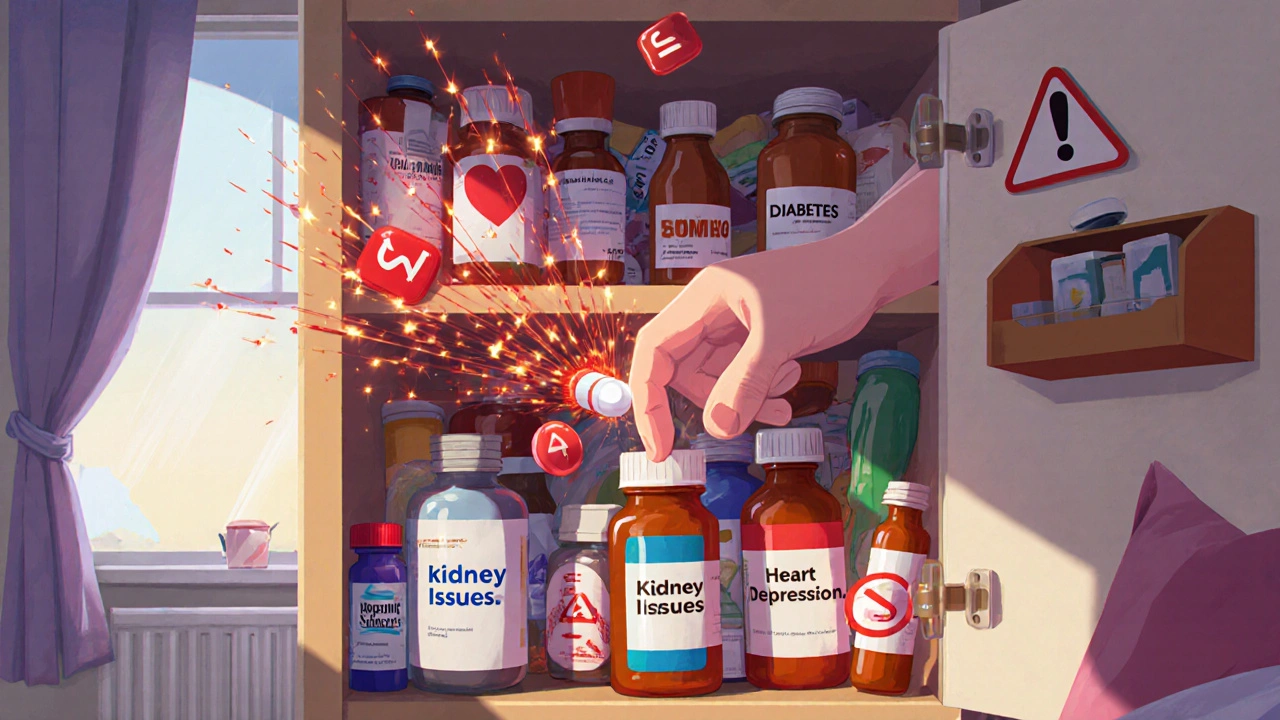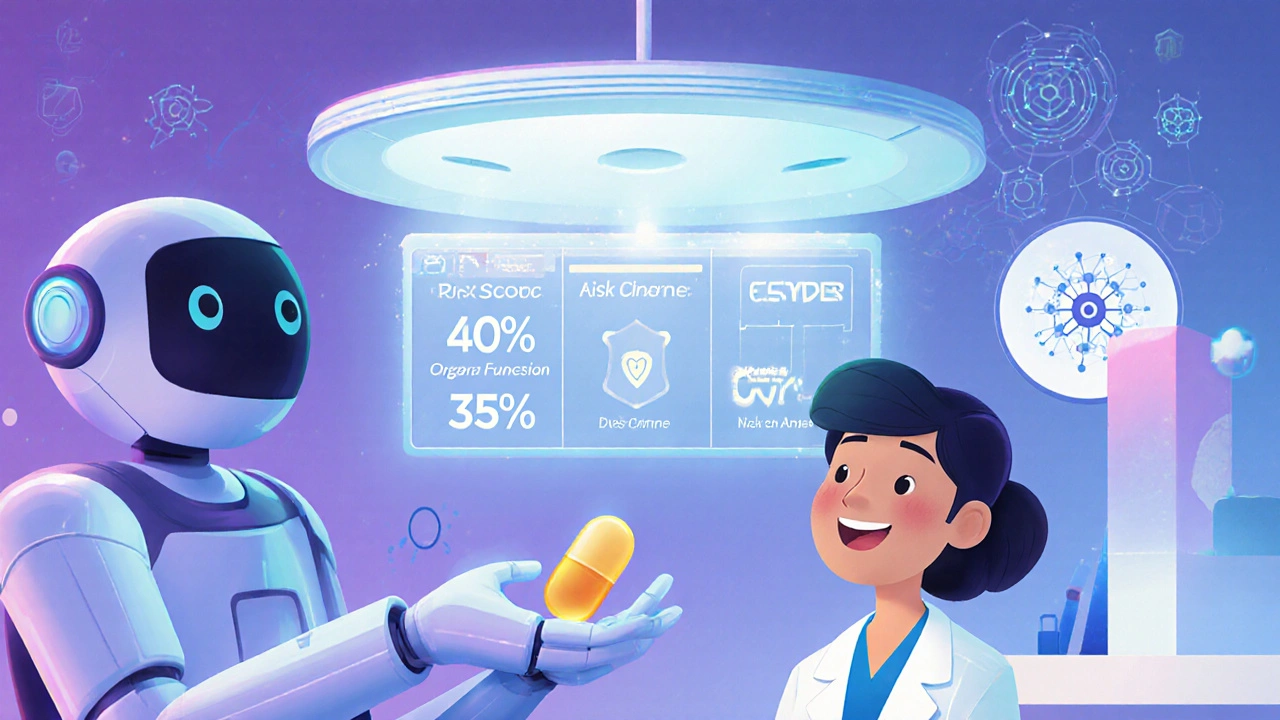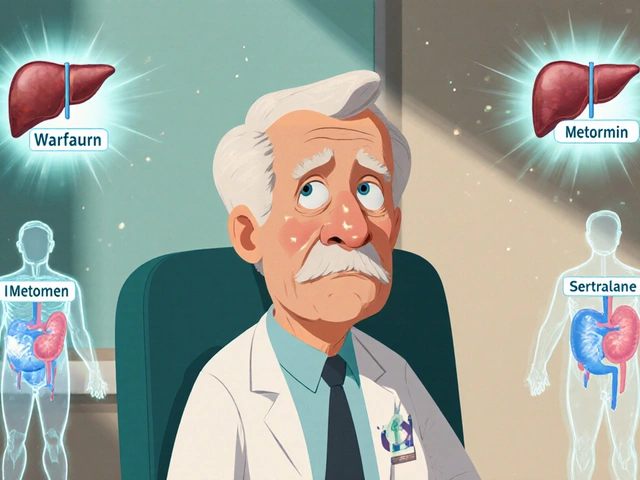Drug Interaction Risk Calculator
Step 1: Select Your Health Conditions
Select all conditions that apply. Some conditions significantly increase drug side effect risks.
Step 2: List Your Current Medications
Enter medications you're currently taking. Include prescription drugs and common OTC medications like NSAIDs or acetaminophen.
When you take a new medication, you’re told about the common side effects: maybe nausea, dizziness, or fatigue. But if you’re managing one or more chronic health conditions, those side effects aren’t just inconvenient-they can be dangerous. Comorbidities don’t just add complexity to your treatment plan; they fundamentally change how your body responds to drugs, often making side effects more frequent, more severe, and harder to predict.
Why Existing Conditions Make Drugs Riskier
Your body doesn’t treat every drug the same way. When you have conditions like diabetes, heart disease, kidney problems, or liver damage, your body’s ability to absorb, break down, and get rid of medications changes. This isn’t just theory-it’s measurable. A 2017 study found that patients with multiple chronic conditions were nearly three times more likely to have an adverse drug reaction than those without. The reason? Chronic diseases alter your body’s chemistry in ways that drug manufacturers often don’t account for in clinical trials. For example, liver disease can cut the activity of key enzymes (like cytochrome P450) by up to 50%. These enzymes are responsible for breaking down more than 70% of commonly prescribed drugs. If they’re slowed down, the drug stays in your system longer, building up to toxic levels. The same thing happens with kidney disease. If your kidneys can’t filter out a drug properly, it lingers, increasing the chance of overdose-even if you’re taking the right dose.The Polypharmacy Trap
Most people with multiple health conditions end up on multiple medications. In fact, nearly half of adults over 65 with three or more chronic illnesses take five or more drugs daily. This is called polypharmacy, and it’s one of the biggest drivers of dangerous drug interactions. Each new medication adds another layer of risk. A drug meant to lower your blood pressure might interact with your diabetes medication, causing your blood sugar to crash. An antidepressant might make your heart rhythm unstable if you already have heart disease. One study of cancer patients found that 65% of them had at least one dangerous drug interaction, and more than a third of those were classified as major-meaning they could cause permanent harm or even death. The problem isn’t just the number of pills. It’s how they work together. For instance, if you’re on an anticoagulant like warfarin and also take an antibiotic that affects liver enzymes, your blood can become dangerously thin. These interactions don’t always show up on a lab test. They creep in slowly, and by the time you feel dizzy or notice unusual bruising, it’s already too late.Common Side Effects in People with Comorbidities
The side effects you experience aren’t always the ones listed on the pill bottle. In patients with multiple chronic conditions, the most common reactions are weakness (36%), dizziness (11.8%), headache (7.3%), nausea (4.9%), and insomnia (2.9%). These might seem minor, but in someone with heart failure or Parkinson’s, dizziness can mean a fall-and a broken hip. Weakness can lead to muscle loss and mobility issues, making recovery harder. Interestingly, the pattern of side effects changes based on your conditions. In healthy people, dizziness is often linked to blood pressure drops. But in those with comorbidities, dizziness is more likely caused by drug buildup in the brain or nerve sensitivity. One study showed that 19% of side effects in healthy patients were dizziness-but only 12% in those with chronic conditions. That shift tells us the root cause is different. It’s not the drug alone. It’s the drug plus your disease.
High-Risk Conditions and Dangerous Drug Pairs
Some combinations are especially risky. If you have liver disease, avoid drugs like acetaminophen (Tylenol) at high doses-even the recommended amount can be toxic. If you have kidney disease, NSAIDs like ibuprofen can cause sudden kidney failure. If you have heart disease, certain antibiotics or antifungals can trigger dangerous heart rhythms. People with substance use disorders face another layer of risk. Nearly 80% of those in treatment for alcohol or opioid addiction also smoke. Smoking affects how your liver processes medications, making antidepressants, painkillers, and even blood thinners less effective-or more toxic. If you’re on methadone for opioid use and also take an SSRI for depression, you’re at higher risk of serotonin syndrome, a life-threatening condition. Older adults are especially vulnerable. The Beers Criteria-a list of medications that should be avoided in seniors-shows that nearly half of older patients are still prescribed at least one of these risky drugs. Women over 75 are almost three times more likely to be given a dangerous medication than younger patients. Why? Because doctors often don’t adjust doses for age or comorbidities, and many prescriptions come from different specialists who don’t talk to each other.Why Clinical Trials Don’t Tell the Whole Story
Most drug trials exclude people with multiple chronic conditions. They want clean data, so they pick healthy volunteers or patients with just one disease. That means when a drug gets approved, we don’t really know how it behaves in someone with diabetes, heart failure, and arthritis-all at once. Studies show that 70-80% of elderly patients with three or more conditions were excluded from the trials that approved their medications. So when your doctor prescribes a new drug, they’re often guessing how it will affect you. The label says “take one pill daily.” But if your kidneys are only working at 40% capacity, that one pill could be the equivalent of three.


Been there. Took warfarin for AFib and then got diabetes. One day I just felt like a ghost walking around. Turned out the metformin was making the warfarin stick around way too long. My pharmacist caught it before I ended up in the ER. Don't wait until you're dizzy to ask questions.
You people are so dramatic!! It's just pills!! Why do you all act like you're dying?? I've been on 8 meds for 10 years and I'm fine!! Stop being weak!!
Let’s analyze the data: 70–80% exclusion rate in clinical trials? That’s not a gap-it’s a chasm. The FDA’s approval framework is fundamentally flawed when it excludes the very populations most likely to use the drug. The 2017 adverse reaction study? Underpowered. Sample size was 1,200. Need at least 5,000 to account for comorbidity variance. Also, why no mention of pharmacogenomics? CYP2D6 polymorphisms alone account for 25% of variability in drug metabolism. This post is well-intentioned but superficial.
My mom’s on 11 medications. Her cardiologist, endocrinologist, and neurologist all gave her new scripts without talking to each other. She was passing out every afternoon. We took her to a clinical pharmacist who did a full med review-cut 4 drugs, adjusted 3 doses. She’s been walking without a cane for 8 months now. If your doctor won’t do a med review, go to a pharmacy that offers it. Many are free with insurance. It’s not a luxury-it’s a lifesaver.
Bro, I’m from Kerala, India. My uncle had diabetes, kidney failure, and high BP. He was on 9 pills. One day he just stopped feeling like himself. His nephew-a med student-sat down with him and wrote down every pill, every time he took it. They found three interactions nobody noticed. Now he’s on 4 pills. He plays cricket with the grandkids again. It’s not about the science alone-it’s about someone caring enough to sit down and listen. You’re not alone. We’ve all got someone like this in our family.
so like... why do people even take meds? just eat better. my cousin had diabetes and quit sugar and now she's fine. problem solved. stop blaming doctors and drugs. its your fault you're sick
my dad’s 72. took him 6 months to realize his blood pressure med was making him dizzy. he thought it was just getting old. one day he fell. broke his hip. turned out the beta-blocker was stacking up because his kidneys were slowing down. we got him switched to a different one. now he walks again. nobody told him to track it. nobody asked. just assumed. that’s the problem.
It’s funny how we treat the body like a machine you can just upgrade with new software. But it’s not. It’s a living, breathing, adapting system. Every pill you take doesn’t just act-it converses. With your liver. Your kidneys. Your nerves. Your heart. And when you’ve got multiple conditions? That conversation gets messy. But that doesn’t mean it’s broken. It just means we need to listen harder. Not just with labs. With stories. With patience.
I cried reading this. My grandma took a new antidepressant and started hallucinating. We thought it was dementia. Turns out it was the interaction with her blood thinner. She was fine after they stopped it. But she was terrified for weeks. No one asked if she’d changed. No one thought to connect the dots. I wish I’d known this sooner.
Deprescribing isn’t giving up-it’s reclaiming control. My aunt was on 12 medications for 15 years. Half were for conditions she no longer had. She felt like a zombie. After a pharmacist-led review, she dropped 5. Her energy came back. Her sleep improved. Her mood lifted. She said it felt like she got her life back. And she didn’t lose a single health benefit. Sometimes less really is more.
Ugh. Another ‘drug danger’ post. Just stop taking so many pills. Problem solved. Also, why are you all so obsessed with side effects? It’s not a horror movie.
Most of you are just scared of medicine because you don’t understand pharmacology. The real issue is lazy doctors not reading the literature. Not the drugs. Also, STOPP/START? That’s a 2008 guideline. We’re in 2025. You need AI-driven clinical decision support, not paper checklists. And no, your ‘symptom journal’ won’t help if you can’t interpret lab values.
I work in a clinic in Lagos. We don’t have fancy tools. We don’t have electronic records. But we have families. We sit with them. We ask: ‘What’s changed since you started this new medicine?’ We write it down on paper. We call the pharmacy. We talk to the nurse. We don’t wait for AI. We wait for people to care. This post? It’s true. But the solution? It’s not tech. It’s love.
Look, I’m a biochemist. I’ve read the trials. The NIH database? Useless. It’s observational data with selection bias. Machine learning models? Trained on flawed datasets. Real personalized dosing? Still 10 years away. Stop treating this like a TED Talk. The truth? We’re flying blind. And no amount of ‘symptom tracking’ fixes that. You need better trials. Better regulators. Better science. Not just ‘ask your pharmacist.’
THIS. This right here. I’ve been fighting my insurance company for a year to get my mom’s meds reviewed. They said ‘no need.’ I showed them the Beers Criteria. They still said no. So I took her to a free clinic. The pharmacist spent 90 minutes with us. Cut two meds. Adjusted two others. She hasn’t fallen since. If you’re reading this and you’re caring for someone older? Don’t wait for permission. Fight for them. Even if it’s one pill at a time.